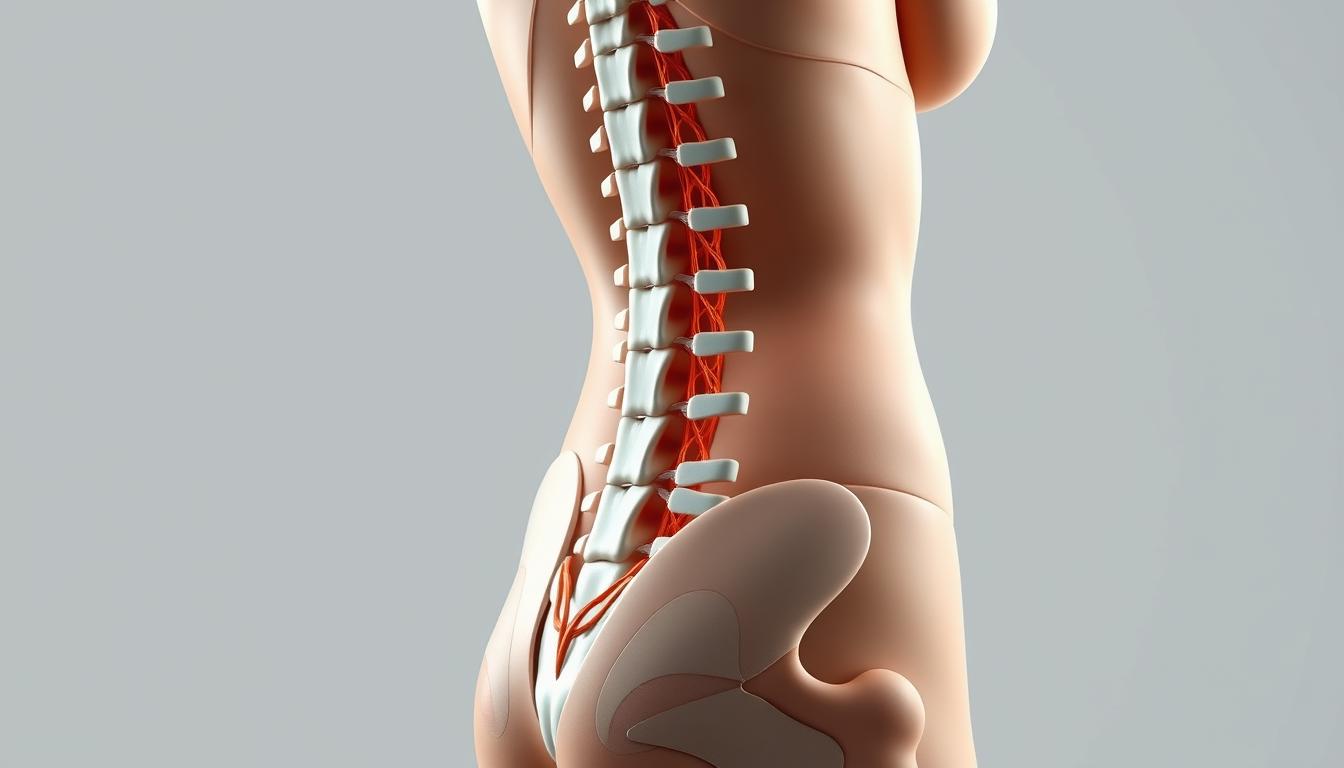Causes of Lower Back Pain in Females & How to Treat It
Lower back pain in females can stem from various sources. Common causes include muscle strain, herniated discs, sciatica, and degenerative spine changes. However, female-specific conditions like menstrual cramps, endometriosis, and pregnancy-related changes also play a role.
Patterns in back pain are significant. Many women experience back pain that aligns with their menstrual cycle, linked to hormonal changes. Pregnancy often introduces mid-pregnancy pain due to weight gain and ligament relaxation. Soft-tissue injuries from lifting or twisting are frequent and often resolve with rest and over-the-counter pain relief.
Some symptoms indicate nerve or structural problems. Sciatica can cause burning or electric shock sensations in one leg. Herniated discs may lead to both localized and radiating pain. Red flags include fever with back pain, changes in bowel or bladder function, progressive leg weakness, or inability to stand, requiring immediate medical evaluation.
Key Takeaways
- Female lower back pain triggers include both general causes and sex-specific conditions like endometriosis and pregnancy.
- Many women experience cyclical lower back pain tied to the menstrual cycle.
- Soft-tissue strains are common and often respond to home care: rest, ice/heat, and OTC NSAIDs.
- Sciatica and disc problems produce radiating, sometimes numb, leg symptoms that may need imaging or targeted treatment.
- Seek urgent care for fever, bowel/bladder changes, severe weakness, or after trauma.
- Treatments range from conservative care and physical therapy to hormonal therapies and surgical options for severe cases.
Understanding Lower Back Pain in Females: An Overview
Lower back pain is a common issue in clinics and urgent care centers across the United States. The World Health Organization and neurology societies identify muscle strain, overuse, arthritis, and disc problems as frequent causes. This sets the stage for examining specific lower back pain contributors in females and their differences from the general population.
Why Lower Back Pain Is Common
Daily activities like lifting groceries, sudden twisting, and repetitive bending strain muscles and ligaments. With age, wear-and-tear leads to osteoarthritis and disc degeneration, causing chronic pressure and stiffness. Sports injuries and sedentary jobs also increase the risk of back pain in women, ranging from acute strain to long-term structural changes.
Anatomical Differences That Affect Back Pain In Females
The female pelvis is generally wider, affecting lumbar curvature and weight distribution. Pregnancy further alters this, moving the center of gravity forward and relaxing ligaments. These biomechanical and hormonal changes explain why some back pain patterns are more prevalent in women.
When To Seek Medical Attention
Certain signs require immediate medical evaluation. Look for inability to walk or stand, high fever with back pain, sudden bowel or bladder changes, growing leg weakness, severe abdominal pain, or trauma. Also, seek professional help if severe pain persists for a week, especially if symptoms suggest endometriosis, pelvic inflammatory disease, ovarian torsion, or pregnancy-related complications.
Causes Of Lower Back Pain In Females
Women experience lower back pain for various reasons, from common muscle strains to reproductive health issues. Understanding both female-specific and general causes is key. It helps both readers and healthcare professionals identify patterns and choose the right treatments.
Overview Of Female-Specific And General Contributors
Female-specific causes include PMS, PMDD, dysmenorrhea, endometriosis, adenomyosis, fibroids, ovarian cysts, pelvic inflammatory disease (PID), and pregnancy. General contributors include muscle strain, ligament sprain, herniated disc, disc degeneration, sciatica, spinal stenosis, osteoarthritis, and scoliosis. This mix explains why diagnosing lower back pain in women often requires a comprehensive approach.
How Menstrual Cycle Factors Play A Role
Menstrual pain often stems from prostaglandin release and hormonal shifts. These changes trigger uterine contractions, causing pain in the lower back and hips. Dysmenorrhea typically worsens in the first few days of menstruation. PMDD and severe PMS can intensify symptoms, making back pain more severe in the premenstrual week.
Why Differentiating Causes Matters For Treatment
Identifying the cause of pain is crucial for effective treatment. Cyclical pain may respond to NSAIDs, heat, or hormonal contraception. In some cases, GnRH agents are necessary. Endometriosis might require laparoscopy and hormonal suppression. Structural spine issues need imaging, targeted rehabilitation, and sometimes surgery. It’s also vital to rule out infection, ovarian torsion, or obstetric complications for safe, effective care.
Muscle Strain And Soft Tissue Injuries As Lower Back Pain Causes
Soft tissue injuries are a leading cause of lower back pain. Activities like a quick lift, sudden twist, or hours of hunching over a laptop can strain lumbar muscles. Women, especially those with demanding jobs, caregiving roles, or intense fitness routines, often experience these strains more frequently.
Typical Activities That Lead To Muscle Strain
Repetitive heavy lifting and awkward bending or twisting put stress on lumbar muscles. Sudden, jerky movements and overstretching during sports or chores can cause small tears. Sedentary work with poor ergonomics leads to muscle fatigue, increasing injury risk. Tasks that require frequent reaching or carrying also heighten the risk.
Symptoms Of Strains And Sprains
Dull, aching pain in the lower back is common. Muscles may feel tight or go into spasm. Pain typically worsens with movement and improves with rest. Some experience mild radiating discomfort without clear nerve signs. Sprains may cause localized tenderness and swelling at the injury site.
Immediate Home Care: RICE, Heat And Ice, OTC Meds
In the first 48 hours, ice reduces inflammation and bruising. After that, heat aids circulation and loosens stiff muscles. Follow RICE principles—rest, ice, compression when useful, and elevation for limb injuries—while avoiding long bed rest. Gentle movement aids recovery.
Over-the-counter NSAIDs like ibuprofen or naproxen ease pain and swelling. Acetaminophen is an alternative for pain control when NSAIDs are unsuitable. Use lumbar support when sitting, place a pillow under the knees when lying on the back, and progress to light stretching as pain allows.
Recognizing these common back pain triggers women face helps tailor recovery. Treat early strains with sensible care so normal activity can return without lingering stiffness or weakness.
Menstrual-Related Back Pain: PMS, PMDD, And Dysmenorrhea
Menstrual lower back pain is a common issue, influenced by hormones, inflammation, and muscle tension. Women often link this pain to their menstrual cycle. However, the exact causes vary among individuals. Small changes in estrogen, progesterone, and prostaglandins can significantly impact how the body feels each month.
How Prostaglandins And Hormones Cause Pain
Prostaglandins from the uterus cause contractions and inflammation. Higher levels of prostaglandins lead to stronger cramps and more pain in the lower back. Changes in estrogen and progesterone affect muscle tone and pain sensitivity, making some cycle phases more painful.
Symptoms And Timing Related To The Menstrual Cycle
PMS-related back pain starts a few days before menstruation and subsides shortly after. Dysmenorrhea occurs during menstruation and can last one to three days. The pain can range from dull to sharp, affecting the lower abdomen, hips, and legs.
PMDD brings severe emotional and physical symptoms in the luteal phase. Women with PMDD may experience intense pain that disrupts daily life and work. Recognizing the pattern and timing helps differentiate menstrual lower back pain from other causes.
Self-Care And Medical Treatments For Menstrual Back Pain
Initial relief comes from NSAIDs like ibuprofen or naproxen, which reduce prostaglandin production. Heat therapy, such as heating pads or warm baths, relaxes tense muscles. Gentle exercise, stretches, and restorative yoga also help.
Hormonal contraceptives can reduce pain by suppressing ovulation and thinning the uterine lining. For severe symptoms, stronger analgesics or SSRIs for PMDD may be prescribed. It’s crucial to evaluate for endometriosis or other pelvic conditions when standard treatments fail, as these conditions require different treatments.
| Symptom | Typical Timing | First-Line Care |
|---|---|---|
| Cramps with lower back ache | During menstruation, 1–3 days | NSAIDs, heat, light exercise |
| Premenstrual back heaviness | 2–4 days before bleeding | Rest, stress reduction, gentle stretching |
| Severe cyclical pain with mood changes | Luteal phase (PMDD) | SSRIs, hormonal options, mental health support |
| Persistent or worsening pain | Across cycles or non-cyclic | Gynecologic evaluation for endometriosis or other causes |
Endometriosis And Adenomyosis: Pelvic Conditions Causing Lower Back Pain
Pelvic conditions like endometriosis and adenomyosis often cause persistent lower back pain. These disorders lead to inflammation and tissue distortion beyond the pelvis. They are common causes of lower back pain in females, as pelvic inflammation can affect sacral and lumbar nerves.
How Ectopic Endometrial Tissue Creates Pelvic And Back Pain
Endometrial tissue outside the uterus, on ovaries or near the bowel and bladder, bleeds with each cycle. This bleeding causes inflammation, scar tissue, and adhesions. These changes pull on ligaments and press on nerves, leading to lower back pain.
Adenomyosis involves endometrial tissue inside the uterine muscle. This causes the uterus to swell and become tense. The inflammation and contraction lead to deep pelvic pain and dull lower spine pain.
Symptoms Beyond Back Pain: Bowel, Bladder, Fertility Issues
Women with these conditions often experience severe menstrual cramps, heavy or irregular bleeding, and bloating. They may also have pain during intercourse, painful bowel movements, or urination during menses. Fertility problems or repeated miscarriages can also occur.
Due to overlapping symptoms with irritable bowel syndrome or urinary conditions, a detailed history and pelvic exam are crucial. Imaging like transvaginal ultrasound or MRI can help diagnose adenomyosis or deep infiltrating endometriosis.
Treatment Options: Hormonal Therapy, Surgery, Pain Management
Treatment aims to reduce pain, control bleeding, and preserve fertility when desired. Hormonal therapies suppress ovarian cycles and shrink lesions. Options include combined oral contraceptives, progestins, levonorgestrel IUDs, and GnRH agonists or antagonists.
Analgesics and NSAIDs manage daily pain. Laparoscopic surgery can remove lesions and free adhesions for symptom relief. In severe adenomyosis, hysterectomy may be considered for those who no longer wish to conceive.
Multimodal care combines gynecology, pain management, and fertility counseling. Physical therapy for pelvic floor dysfunction and guided pain strategies enhance function. Recognizing endometriosis and adenomyosis as causes of lower back pain in females leads to timely and tailored care.
Pregnancy-Related Lower Back Pain Causes And Management
Pregnancy introduces rapid changes to posture and the pelvic girdle. As the belly expands, the center of gravity shifts forward. This shift increases the lumbar curve and puts extra strain on the paraspinal muscles. Hormonal changes also affect ligament stiffness, impacting stability and comfort.
Biomechanical Changes And Hormone-Related Ligament Laxity
The hormone relaxin increases to prepare the body for birth. It loosens pelvic ligaments and can reduce support in the lower spine. The increased lumbar lordosis and heavier abdominal weight force the back muscles to work harder. These changes are common causes of female lower back pain during pregnancy.
When Back Pain Appears During Pregnancy And Typical Patterns
Discomfort often starts between months five and seven, though it can begin earlier. Pain typically occurs below the waist or across the tailbone. It may be central or off to one side and can radiate down the legs if nerve roots are irritated. Women with prior spine injuries or chronic discomfort are at higher risk for worsening symptoms. Tracking timing and pattern helps distinguish pregnancy lower back pain from other back pain in women causes.
Safe Treatments In Pregnancy: Posture, Support Belts, Physical Therapy
Nonpharmacologic measures are the first line of treatment. Gentle posture cues, such as tucking the pelvis slightly and avoiding exaggerated sway, reduce strain. Maternity support belts and pelvic belts provide targeted stability for pregnant hips and the lumbar area. Prenatal physical therapy designs exercises that strengthen the core and hip stabilizers without harming the baby.
Low-impact movement is crucial. Short walks, guided prenatal yoga, and tailored strengthening prevent stiffness. Heat packs and careful therapeutic massage can ease tight muscles when used under a clinician’s advice. Over-the-counter NSAIDs are typically limited in pregnancy, so consult an obstetrician before taking medication.
Referral to a physical therapist who specializes in prenatal care is beneficial. They can provide safe manual techniques, exercise progressions, and strategies for daily tasks. Simple workplace adjustments, such as alternating sitting and standing and using a lumbar roll, can make a significant difference.
| Issue | How It Contributes | Recommended Management |
|---|---|---|
| Center of gravity shift | Increases lumbar lordosis and muscle load | Posture training, pelvic tilt exercises, core strengthening |
| Relaxin-related ligament laxity | Reduces joint stability in pelvis and lower spine | Maternity support belts, pelvic stabilization exercises |
| Preexisting back conditions | Higher risk of symptom flare or nerve irritation | Early physical therapy referral, activity modification |
| Prolonged standing or poor ergonomics | Increases muscle fatigue and pain | Frequent breaks, ergonomic chairs, adjustable workstations |
| Inflammation or nerve sensitivity | Can cause radiating pain into the legs | Targeted PT, gentle neural mobilization, obstetric review |
Sciatica And Nerve-Related Lower Back Pain Causes In Women
Sharp, burning, or electric-shock sensations from the low back or buttock down one leg indicate sciatica, not just muscle ache. In women, these nerve pains can be confused with pelvic or menstrual discomfort. It’s crucial to pay close attention to symptom patterns to distinguish nerve-related lower back pain from muscle soreness.
What Sciatica Feels Like And How It Differs From Muscular Pain
Sciatica causes one-sided leg symptoms like numbness, tingling, weakness, or burning sensations down the thigh or calf. In contrast, muscle pain usually stays near the spine or buttock, feeling like an ache or stiffness. A clinical exam that tests reflexes and strength can help differentiate between the two.
Common Causes: Herniated Disc, Spinal Stenosis, Nerve Compression
Herniated lumbar discs can press on nerve roots, causing radiating pain. Degenerative disc disease and spinal stenosis narrow the canal, compressing nerves. Bony spurs, soft-tissue masses, and pregnancy-related pelvic shifts can also cause temporary irritation. These factors are common back pain causes in women and can change with age and activity level.
Diagnostic Steps And Interventions: Imaging, Injections, Surgery
Doctors begin with a detailed history and neurologic exam. If symptoms persist or worsen, an MRI is used to identify disc and nerve problems. Conservative treatments like NSAIDs, targeted physical therapy, and specific stretches can reduce nerve irritation. Epidural steroid injections may provide lasting relief by calming inflammation.
When weakness increases or bladder and bowel control is affected, surgery becomes necessary. Procedures like microdiscectomy or laminectomy remove offending disc material or widen the canal. Decisions on timing and type of intervention are made through shared decision-making with spine specialists and pain clinic teams.
Herniated Disc, Disc Degeneration, And Structural Spine Issues
The spine’s health depends on the intervertebral discs, which act as cushions between vertebrae. When a disc bulges or ruptures, it can press on nerves, causing sharp pain in the lower back. This pressure often radiates down the buttock or leg, a common symptom of sciatica.
Disc wear is a gradual process. Over years, discs lose height and hydration, leading to disc degeneration in the lower back. This loss of shock absorption puts more pressure on facet joints and soft tissues, resulting in aching and stiffness.
Age is a significant risk factor. By their forties, most people show some disc degeneration. Other factors include prior injuries, repetitive strain from lifting or sports, smoking, excess weight, and hormonal changes. Genetics also play a crucial role in how quickly discs wear out.
Conservative care is the first step. This includes modifying activities, physical therapy to strengthen the core, and short-term use of NSAIDs. Epidural steroid injections can also help manage severe nerve irritation.
Surgery is considered when conservative care fails, neurologic deficits persist, or structural instability is evident. Procedures like microdiscectomy remove the offending disc material. Spinal fusion may be necessary for severe degeneration and deformity. Many people find relief without surgery.
Choosing a treatment path involves weighing pain severity, daily function, and long-term goals. A spine specialist, often an orthopedic surgeon or neurosurgeon, works with physical therapists and pain specialists to create a personalized treatment plan. For women with herniated discs, care plans consider pregnancy plans, bone health, and occupational demands.
| Issue | Typical Symptoms | First-Line Treatments |
|---|---|---|
| Bulging Disc | Localized ache, occasional leg tingling | Rest, physical therapy, NSAIDs |
| Herniated Disc | Sharp lumbar pain, radiating sciatica, numbness | PT, epidural steroid injection, activity modification |
| Degenerative Disc Disease | Chronic lower back stiffness, worsens with activity | Core strengthening, lifestyle changes, pain management |
| Facet Joint Arthritis | Localized back pain, worse with extension | Physical therapy, anti-inflammatories, injections |
| Structural Instability | Recurring pain, possible neurologic signs | Specialist evaluation, surgical options if needed |
Gynecologic And Pelvic Infections Or Conditions That Trigger Back Pain
Lower back pain in women often stems from beyond the spine. Pelvic organs are near nerves and muscles that connect to the low back. Infections or gynecologic changes can cause pain that seems like a spine issue but originates from the pelvis.
Pelvic Inflammatory Disease And Associated Back Or Pelvic Pain
Pelvic inflammatory disease (PID) affects the uterus, fallopian tubes, or ovaries. Symptoms include lower abdominal pain, fever, abnormal vaginal discharge, and irregular bleeding. This infection can cause pelvic pain that feels dull or sharp, often worsening with movement.
Antibiotic treatment is crucial to prevent long-term issues like infertility, chronic pelvic pain, or abscess. Seek immediate care if pain is severe or fever is present.
Ovarian Cysts, Fibroids, And Other Reproductive Contributors
Ovarian cysts are common and often resolve on their own. However, larger cysts can press on pelvic tissues, leading to ovarian cyst back pain that radiates to the lower back. Sudden, severe pain may indicate torsion or rupture, requiring urgent evaluation.
Uterine fibroids are benign growths inside the uterus. They can cause heavy bleeding, pelvic pressure, urinary frequency, and sometimes back pain. Clinicians consider imaging, symptom pattern, and menstrual history when investigating fibroids lower back pain causes in females.
When Infection Or Acute Pelvic Events Require Urgent Care
Red flags for urgent care include sudden severe pelvic or back pain, high fever with purulent discharge, fainting, or signs of internal bleeding. Pregnancy with bleeding and back pain requires immediate obstetric assessment.
Conditions like PID with abscess, ovarian torsion, or ruptured cyst can rapidly deteriorate. Early diagnosis is key for timely surgery or antibiotics, improving outcomes.
Lifestyle, Posture, And Chronic Factors Leading To Lower Back Pain In Women
Daily habits significantly impact more than just our mood; they also shape our spine. Small changes in posture, long hours at a desk, and repetitive tasks at work put constant pressure on our lumbar joints and soft tissues. These habits are major contributors to back pain, especially when our core strength is weak and we rarely take breaks.
Our office setups and job demands play a crucial role. Prolonged sitting without proper lumbar support can alter our spinal curves. Jobs like nursing, retail work, and delivery driving involve frequent lifting and twisting, increasing injury risk. Sedentary behavior reduces blood flow and weakens muscles that protect our lower spine.
Impact Of Posture, Sedentary Behavior, And Occupational Factors
Slumped shoulders and forward head position put extra weight on our lower back. Over time, this uneven load affects our discs and ligaments. Repetitive tasks, long drives, or standing for hours can cause microtrauma, turning acute strain into chronic pain.
Simple ergonomic adjustments can help reduce strain. Elevate monitors to eye level, use a chair with lumbar support, and take short walks or standing breaks every 30 to 60 minutes.
Weight, Smoking, And Stress As Contributing Factors
Extra body weight increases the mechanical load on our lumbar spine. This load accelerates wear on discs and joints. Smoking harms disc nutrition and speeds degeneration. Persistent stress tightens back muscles and boosts pain sensitivity, making symptoms feel worse than the original injury.
Managing weight, quitting smoking, and adopting stress reduction techniques can help lower the burden on our spinal structures. This eases symptoms tied to lower back pain contributors in females.
Prevention Strategies: Exercise, Ergonomics, Weight Management
Consistent movement is a powerful shield. A mix of aerobic activity, targeted core strengthening, and regular stretching builds support muscles around the spine. Pilates, swimming, and brisk walking are effective.
At work, adjust chair height and monitor position, use a lumbar roll, and schedule standing breaks. Eating nutrient-dense foods and controlling portions supports healthy weight. Mindful breathing and short meditative breaks reduce muscle tension and interrupt pain cycles.
| Risk Factor | Why It Matters | Practical Steps |
|---|---|---|
| Prolonged Sitting | Weakens core, compresses discs, alters posture | Stand every 30–60 minutes; use sit-stand desk; lumbar support |
| Poor Ergonomics | Forces awkward spine angles during work | Raise monitor, adjust chair, use external keyboard and mouse |
| Excess Weight | Increases mechanical load on lumbar spine | Calorie-aware diet, regular cardio, strength training |
| Smoking | Reduces disc health, speeds degeneration | Tobacco cessation programs, nicotine replacement, counseling |
| Chronic Stress | Raises muscle tension and pain sensitivity | Breathing exercises, mindfulness, short movement breaks |
| Sedentary Occupations | Higher risk of chronic low back pain | Micro-breaks, desk stretches, ergonomic assessment |
Combining these tactics supports long-term spine health. Women who focus on prevention tend to see fewer flare-ups and faster recovery when setbacks occur. Small, steady changes yield the strongest results against common lower back pain contributors in females.
Treatment Approaches: From Home Remedies To Medical Interventions
Lower back pain in women requires a flexible treatment plan. It starts with simple home remedies and progresses to specialist care for persistent or severe pain. This approach ensures effective management of various causes.
Home Care
Warm baths and heating pads can relax tight muscles. Ice packs are best in the first 48 hours to reduce swelling. Over-the-counter NSAIDs like ibuprofen or naproxen help with menstrual and strain-related pain. Gentle walking, pelvic tilts, and simple stretches keep the spine mobile.
Sleep changes, such as a pillow between the knees for side sleepers, also help. These practical home remedies are often the first line of defense before seeking further care.
Physical Therapy And Exercise
Physical therapists at clinics like Cleveland Clinic and Kaiser Permanente create programs to strengthen the core and correct posture. Short supervised sessions focus on flexibility, manual therapy, and safe lifting techniques. Low-impact activities like swimming or walking can lower recurrence rates.
Tailored plans address pregnancy-related discomfort, sciatica, and rehab after surgery. This ensures a personalized approach to each patient’s needs.
Medications, Injections, Hormonal Therapies, And Surgery
Prescription options include muscle relaxants and short courses of stronger analgesics when pain limits function. Antidepressants are used in selected cases for chronic pain. For endometriosis, gynecologists prescribe combined oral contraceptives, progestins, or GnRH agents to reduce lesions and pain.
Interventional steps include epidural corticosteroid injections for radicular pain. Surgical choices range from laparoscopy to remove endometrial implants to discectomy or decompression for nerve compression. Hysterectomy or myomectomy is considered for specific, refractory uterine conditions.
When To See A Specialist
Refer to a gynecologist for menstrual, ovarian, uterine, or pelvic inflammatory concerns. Consult an orthopedist or spine surgeon for structural spine disease and severe radiculopathy. A neurologist evaluates complex neuropathic signs. A multidisciplinary pain clinic helps patients with chronic, refractory conditions.
Early specialist referral is crucial when red-flag signs or lasting disability appear. This ensures timely and effective management of complex cases.
| Stage | Typical Options | When To Consider |
|---|---|---|
| Self-Care | Heat, ice, OTC NSAIDs, sleep positioning, gentle walks | Acute strains, menstrual cramping, mild daily pain |
| Therapeutic | Physical therapy, tailored stretches, core strengthening | Pain lasting >4–6 weeks, recurrent episodes, pregnancy-related pain |
| Pharmacologic & Interventional | Prescription analgesics, muscle relaxants, epidural injections | Severe radicular pain, poor response to conservative care |
| Specialized & Surgical | Laparoscopy for endometriosis, discectomy, hysterectomy in select cases | Confirmed structural or gynecologic pathology unresponsive to other measures |
Conclusion
Lower back pain in females is a complex issue, influenced by menstrual and gynecologic conditions, pregnancy, and spine or soft-tissue problems. Conditions like dysmenorrhea, endometriosis, fibroids, and ovarian cysts play a significant role. Pregnancy brings changes in posture and hormone levels, adding to the pain. Nerve-related issues, such as sciatica, can make symptoms worse.
Conservative care often helps, including heat or ice, NSAIDs, and targeted exercises. Hormonal therapies or gynecologic treatments can also alleviate symptoms. However, severe cases may need injections or surgery, highlighting the importance of accurate diagnosis.
Seek immediate medical attention for symptoms like progressive weakness, numbness, fever, or severe pelvic pain. A team approach, involving gynecology, orthopedics, physical therapy, and pain specialists, is crucial for effective management. Combining self-care, medical treatment, and timely referrals is key to managing lower back pain in women.
FAQ
What Are The Most Common Causes Of Lower Back Pain In Females?
Lower back pain in females stems from a mix of sex-specific and general causes. Female-specific factors include menstrual-cycle disorders, endometriosis, and uterine fibroids. General causes include muscle strain, herniated discs, and osteoarthritis. Clinicians look for timing and pattern to identify the cause.
How Does The Menstrual Cycle Cause Lower Back Pain?
Cyclical back pain is linked to prostaglandins and hormonal shifts. Prostaglandins cause uterine contractions and inflammation, leading to pain in the lower back. PMS and PMDD often cause premenstrual low-back soreness. Dysmenorrhea causes cramping that peaks during menstruation.
When Should Back Pain During Menstruation Prompt Medical Evaluation?
Seek medical evaluation for severe pain, heavy or irregular bleeding, or deep pain during intercourse. Also, consult a clinician if standard self-care offers little relief or if symptoms worsen.
Why Does Pregnancy Often Trigger Lower Back Pain, And When Does It Start?
Pregnancy changes biomechanics, straining paraspinal muscles. Hormone relaxin loosens pelvic ligaments. Back pain often begins in mid-pregnancy but can start earlier. Preexisting back problems increase the risk of worsening symptoms.
What Immediate Home Care Helps For Soft-Tissue Back Injuries?
For muscle strains and sprains, use ice first, then heat. Rest and gentle mobility are crucial. Over-the-counter NSAIDs or acetaminophen relieve pain. Supportive sitting posture and stretching aid recovery. Seek a clinician if no improvement after a week.
How Can You Tell Sciatica From A Muscular Low Back Ache?
Sciatica feels like burning, sharp, or electric-shock pain down one leg. It may cause numbness or weakness. Muscular ache is a dull ache or tightness, eased by rest or heat.
Which Red-Flag Symptoms Require Urgent Medical Attention?
Seek urgent evaluation for inability to stand or walk, sudden severe back pain, or fever with back pain. Also, for new bowel or bladder incontinence, progressive leg weakness, or suspected ovarian torsion. These signs indicate serious conditions needing prompt care.
What Conservative Treatments Work For Disc-Related Or Degenerative Spine Pain?
First-line treatments include activity modification and physical therapy. Targeted exercises build core strength and flexibility. Short courses of NSAIDs or muscle relaxants help. Epidural steroid injections reduce inflammation for some patients. Surgery may be needed for persistent pain or neurologic deficits.
How Are Gynecologic Conditions Like Endometriosis Treated When They Cause Back Pain?
Medical management starts with hormonal suppression to reduce lesion activity. Analgesics and physical therapy help symptoms. Laparoscopic surgery can provide pain relief and aid diagnosis. Treatment choice depends on pain severity and fertility goals.
What Lifestyle Changes Help Prevent Recurrent Lower Back Pain In Women?
Prevention involves regular exercise and core-strengthening routines. Ergonomic workspace adjustments and weight management are key. Stretching, good sleep positioning, and proper lifting mechanics lower injury risk.




